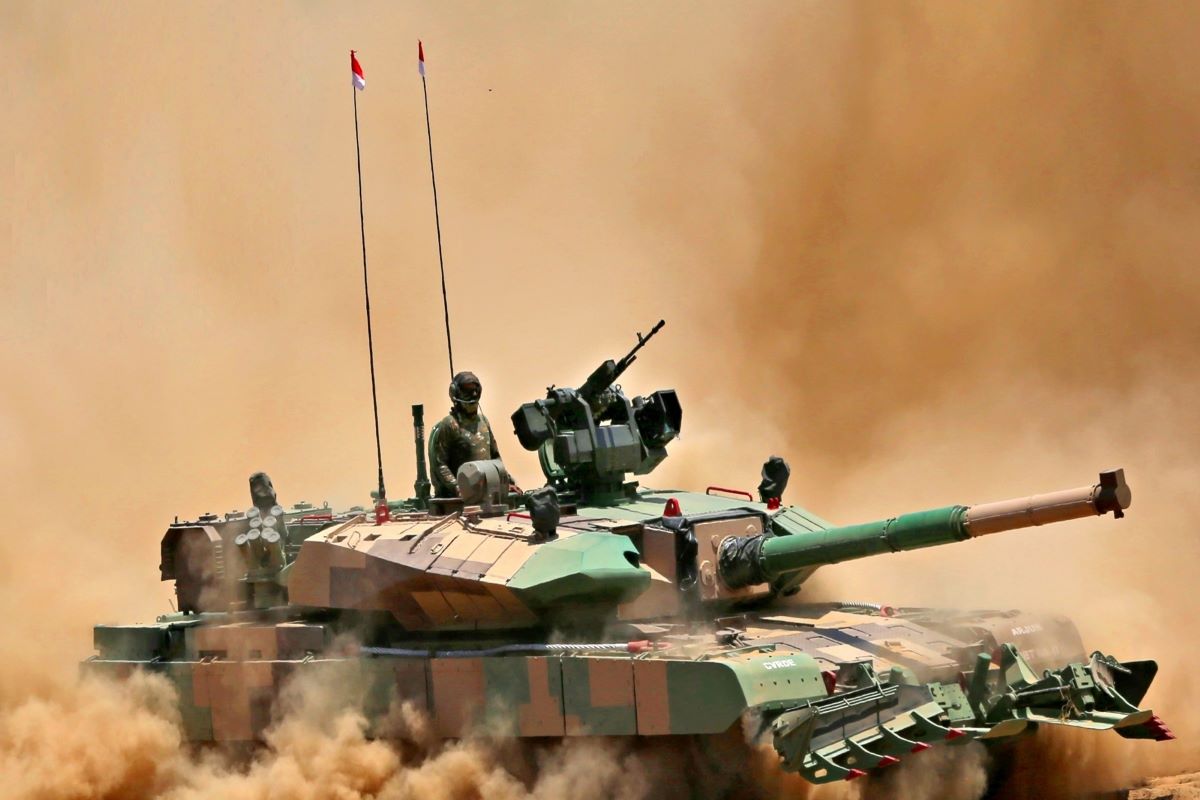A record allocation of over Rs 6.21 lakh crore for defence sector has been made in the Interim Budget 2024-25 presented by Union Finance Minister Nirmala Sitharaman in Parliament on Thursday.
The Defence Budget has touched Rs 6,21,540.85 crore in the Financial Year 2024-25. This comes out to be 13.04 per cent of the total Interim Budget.
The Ministry of Defence (MoD) continues to receive the highest allocation among the Ministries. The budgetary allocation to Defence for FY 24-25 is higher by approximately one lakh crore (18.35 per cent) over the allocation for FY 2022-23 and 4.72 per cent more than allocation of FY 23-24.
Of this, a major share of 27.67 per cent goes to capital, 14.82 per cent for revenue expenditure on sustenance and operational preparedness, 30.68 per cent for Pay and allowances, 22.72 per cent for defence pensions and 4.11 per cent for civil organisations under the MoD.
Budgetary allocation for capital expenditure in Defence for FY 24-25 is Rs 1.72 lakh crore which is 20.33 per cent higher than the actual expenditure of FY 22-23 and 9.40 per cent more than the Revised Allocation of FY 23-24. The allocation is in line with the Long Term Integrated Perspective Plan (LTIPP) of the three Services aimed to fill the critical capability gaps through modernisation of the Armed Forces by materialising some big ticket acquisitions in FY 2024-25. The enhanced budgetary allocation will facilitate in equipping the Armed Forces with state-of-the-art, niche technology lethal weapons, Fighter Aircraft, Ships, Platforms, Unmanned Aerial Vehicles, Drones, Specialist Vehicles etc.
Planned modernisation of the existing Su-30 fleet along with additional procurement of aircraft, acquisition of advanced engines for existing MiG-29, acquisition of transport aircraft C-295 and missile systems will be funded out of the budget being allocated. Apart from this, to take the initiative of ‘Make in India’ further the LCA MK–I IOC/FOC configuration will be additionally funded to ensure state-of-the-art technology in domestic production.
The Indian Navy projects such as acquisition of Deck-based fighter aircraft, Submarines, Next generation survey vessels etc. will all materialise through this allocation. The sizeable allocation under capital is centered around promoting ‘Aatmanirbharta’ in Defence. Large portion of the allocation will be utilised for procurement through domestic sources to provide domestically manufactured next generation weapon system to the country which will have a multiplier effect on the GDP, create employment, ensure capital formation and provide a stimulus to the domestic economy.
Allocation to the Armed Forces for revenue expenditure (Other than Salary) meant for sustenance and operational commitment for FY 24-25 continues to be high at Rs 92,088 crore, which is 48 per cent higher than the budgetary allocation of FY 2022-23. During the mid-year review, the allocation on this head was increased by 82 per cent over the budgetary allocation of FY 22-23 crossing the figure of Rs one lakh crore for the first time.
This is aimed at providing best maintenance facilities and support system to all platforms, including aircraft and ships. It also facilitates procuring of ammunition, mobility of resources, movement of personnel, catering to day-to-day expenditure of Armed Forces in strengthening the deployment in forward areas and keeping the forces always ready to take care of any eventuality. The continued higher allocation since FY 2023-24 in this head has resolved the grievance of the forces and has improved their sustenance and operational readiness.
Total Budgetary allocation on account of Defence pensions is Rs 1,41,205 crore which is 2.17 per cent higher than the allocation made during 2023-24. It will be incurred on monthly pension to approx. 32 lakh pensioners through SPARSH and through other pension disbursing authorities.
The total allocation to Ex-Servicemen Welfare Scheme for FY 2024-25 is 28 per cent higher than the allocation for FY 23-24 (From Rs 5,431.56 crore to Rs 6,968 crore). This is in addition to the unprecedented allocation at revised estimate stage during the current year where the budgetary allocation to ECHS was enhanced by 70 per cent over BE of 2023-24 and was made to Rs 9,221.50 crore.
This significantly higher allocation is to take care of Medical Treatment Related Expenditure (MTRE) incurred during the COVID period and to compensate the increase in ECHS rates bringing it at par with the CGHS rates. This is in line with the Government’s resolve to provide best health care facilities to Ex-Servicemen, War veterans, Veer naris and their family members.
In the light of the continued threat perception faced at the Indo-China border, there continues a jump in the Capital Budget allocation to the Border Roads Organisation. The allocation for BE 2024-25 is Rs 6,500 crore, which is 30 per cent higher than the allocation for FY 23-24 and 160 per cent higher over the allocation of FY 2021-22. This indicates the commitment of the Government to improve border infrastructure.
The financial provision made during the budget this year, will, apart from promoting strategic infrastructural development in the border areas, also boost socio-economic development in that region along with promoting tourism. Projects such as development of Nyoma Air field in Ladakh at an altitude of 13,700 feet, permanent bridge connectivity to southernmost Panchayat of India in Andaman and Nicobar island, 4.1 km strategically important Shinku La tunnel in Himachal Pradesh, Nechiphu tunnel in Arunachal Pradesh and many other projects will be funded out of this allocation.
Allocation to the Indian Coast Guard (ICG) for this FY 2024-25 is Rs 7.651.80 crore which is 6.31 per cent higher over the allocation of FY 2023-24. Of this, Rs 3,500 crore is to be incurred only on capital expenditure, adding teeth to the arsenal of the ICG to address the emerging challenges posed in water and provide humanitarian assistance to other nations. The allocation will facilitate the acquisition of fast moving patrolling vehicles/interceptors, advanced electronic surveillance systems and weapons.
The budgetary allocation to Defence Research and Development Organisation (DRDO) has been increased to Rs 23,855 crore in FY 2024-25 from Rs 23,263.89 crore in FY 2023-24. Of this allocation, a major share of Rs 13,208 crore is allocated for capital expenditure. This will financially strengthen the DRDO in developing new technology with special focus on fundamental research and hand-holding the private parties through Development-cum-production partner.
Allocation to Technology Development Fund (TDF) scheme stands out to be Rs 60 crore which is especially designed for new start-ups, MSMEs and academia attracting the young bright minds interested in innovation and developing niche technology in the field of defence in collaboration with the DRDO. The announcement regarding a Rs one lakh crore corpus for Deep Tech for long term loan to tech-savvy youth/companies and the tax advantage to the start-ups will give further impetus to innovation in the defence sector.
Meanwhile, through a post on X, Defence Minister Rajnath Singh congratulated the Union Finance Minister for presenting a positive and encouraging ‘Interim Budget’, which outlines the vision for a confident, strong and self-reliant ‘Viksit Bharat’. The Budget gives a glimpse of India’s rapid economic transformation, inspired by Prime Minister Narendra Modi’s vision of making India a developed nation by 2047, he said.
Singh added that there is big push for infrastructure, construction, manufacturing, housing and technology development in this Budget. “During the COVID-19 when the world was faltering India emerged as the beacon of hope. This Budget is perfectly aligned with PM’s ‘Panchamrit Goals’ and it also paves the way for the next five years of unprecedented growth,” he said.
On the increase of capital expenditure outlay, Singh described it as a massive push, which will provide a big boost to making India a five trillion dollar economy by 2027.












